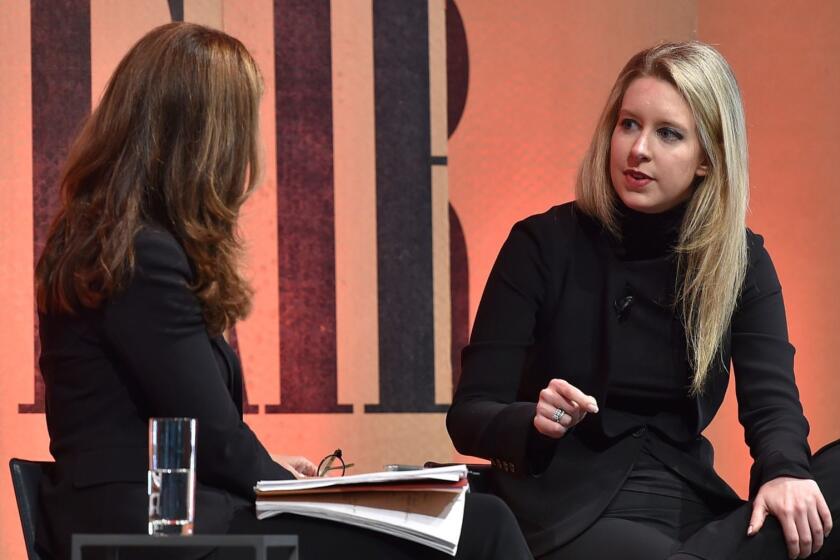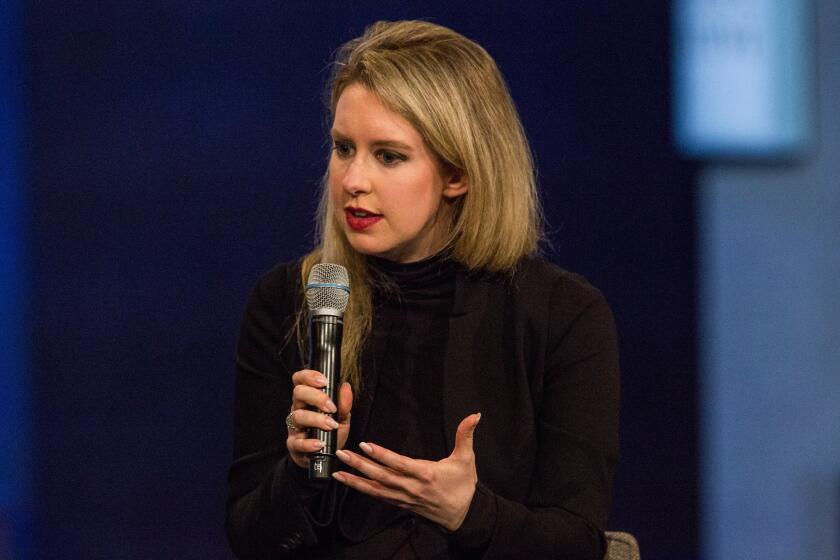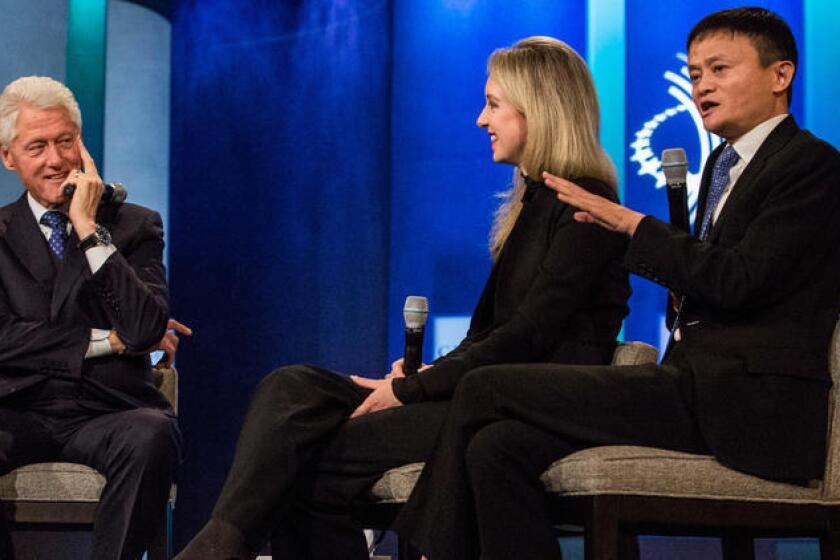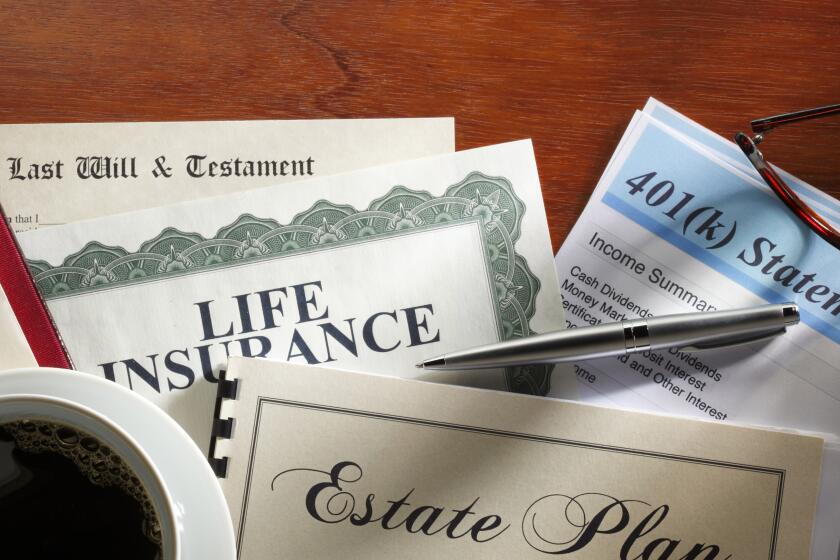Column: The Theranos verdict won’t stop investors from pouring money into the next big fraud
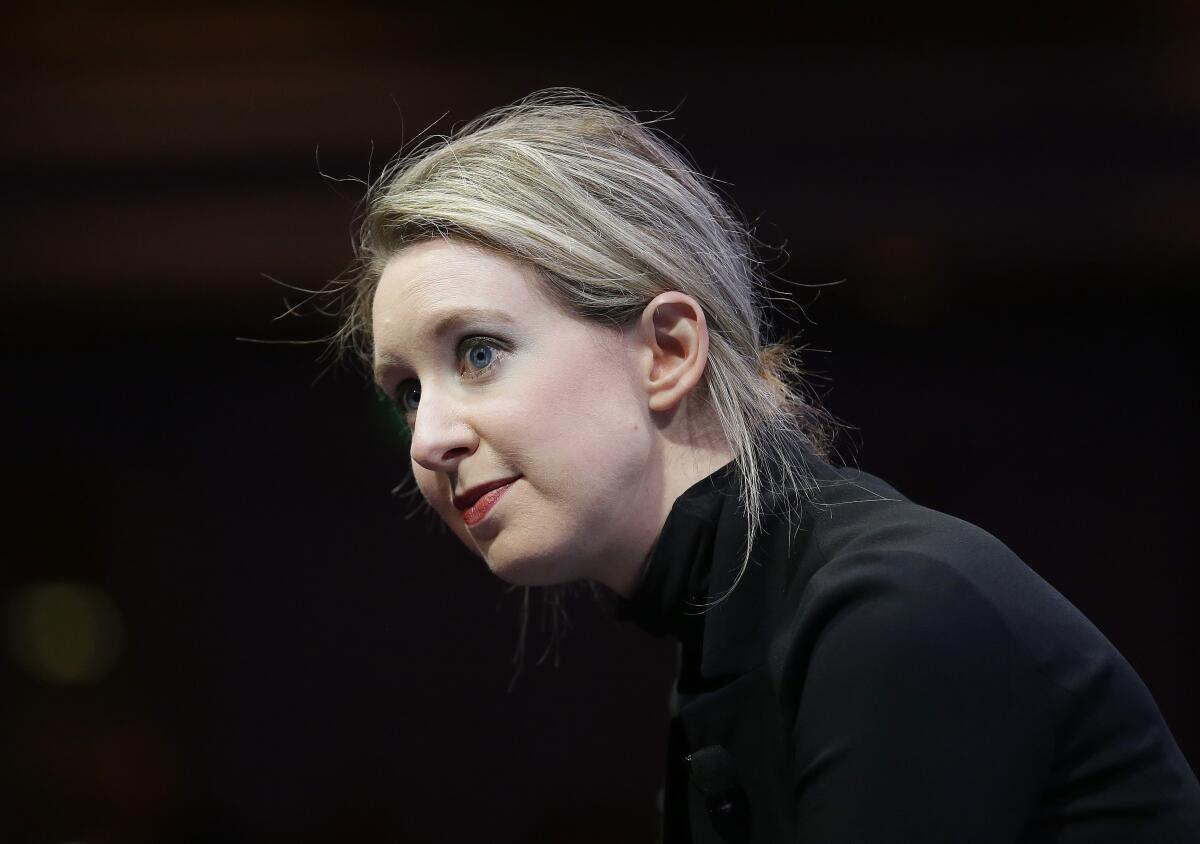
- Share via
Elizabeth Holmes, the founder and chief executive of the medical device company Theranos, was convicted Monday on multiple counts of defrauding investors following a four-month trial in federal court in San Jose.
Theranos, which rode a tide of positive publicity in 2013 and 2014 after introducing what it claimed was novel technology for making blood testing simpler, cheaper and more efficient, shut down in 2018 after investigations established that the claims were false. Holmes and her second-in-command, Ramesh “Sunny” Balwani, were indicted on 12 counts of fraud in 2020; one count was later dropped. Balwani’s trial is scheduled for this year.
The jury acquitted Holmes on several counts related to accusations Theranos defrauded patients who relied on the company to deliver accurate blood test results, and deadlocked on three others related to transfers of funds from investors. For the most part, the jury found against Holmes on charges that she plied investors with claims about the firm’s technology that were largely fabricated. Those counts included three of fraud and one of conspiracy to defraud.
The case raises the important question of whether the testimony and result will serve as object lessons for investors confronted with cheery promises in the future. Bet your money that the answer is “no.”
High-tech investing is predisposed to take even clearly hyperbolic projections as part of the game.
Not only was risk-taking glorified, but failure was socially acceptable.
— Annalee Saxenian, UC Berkeley, describing Silicon Valley culture
Holmes’ defense argued in effect that the misinformation with which Theranos plied investors was characteristic of tech industry exaggeration at best — that investors were experienced enough to interpret Holmes’ projections as “uncertain,” not fraudulent.
To a certain extent, that’s true. All entrepreneurs making pitches to venture capital funds are inclined to promise castles in the air and riches beyond the dreams of Croesus, or they won’t be invited through the door.
Venture investors know well that most of these claims encompass a sizable helping of hyperbole; that’s why they strive to assemble diversified portfolios, in the hope that the handfuls of successes and tinier handfuls of massive successes will pay for the losers.
Get the latest from Michael Hiltzik
Commentary on economics and more from a Pulitzer Prize winner.
You may occasionally receive promotional content from the Los Angeles Times.
The venture investment community is periodically inundated with such a torrent of capital that too much money ends up chasing too few deals. The more than 500 U.S. venture capital funds raised a record $96 billion in the first nine months of 2021 and closed a record of more than 11,000 deals.
The current frenzy is driven in part by what venture investors call “tourists” — investors coming from outside the venture community and bidding up deal prices.
“When tourists flock to hot vacation spots, the prices jump at the popular resorts, hotels and restaurants,” the Seattle financial data firm PitchBook observes. “The same thing is happening now as these tourist investors pile into competitive venture deals for hot startups, especially at the early stage.”
The Securities and Exchange Commission on Wednesday wrote what may be the final chapter in the book of Theranos.
In 2013, when venture investor Aileen Lee first coined the term “unicorn” for startups valued at $1 billion or more, she identified 39. Today, the venture research firm CB Insights lists more than 900.
The first investments beget further investments in what may appear to be the next big thing, as firms pile in out of FOMO — “fear of missing out.” Sober judgments about the technology underlying entrepreneurs’ promises? Don’t expect them.
The nature of Silicon Valley as a self-reinforcing ecosystem owes much to Annalee Saxenian and her 1994 book “Regional Advantage.” A professor of information sciences at UC Berkeley, Saxenian identified the key to the valley’s success as a culture in which “not only was risk-taking glorified, but failure was socially acceptable.”
That culture grew within an infrastructure that brought together experienced engineers and venture investors with “lawyers, market research firms, consulting companies, public relations companies” and other service providers specializing in the technology industry.
Starting as long ago as the 1930s with the founding of Hewlett-Packard, but especially from the 1970s through the 1990s, that system worked to foster explosive growth and the creation of many of the signature companies of high technology — Intel, Apple and Google among them.
More recently, however, the system has started to look like a caricature of itself, especially as less discerning investors flow in. Risk-taking and failure are not merely the source and outgrowth of ambition, but almost ends in themselves. The system has shown that it can not only pave the way to success, but also reinforce fraud and failure by making them seem like milestones along the way.
To attract investors, a company no longer has to demonstrate that it has a working technology or rational business plan, but merely to promise to “disrupt” an established industry. Uber would “disrupt” the taxi industry. Zillow would disrupt home buying.
Theranos Inc. is a Silicon Valley start-up that over the past year had been acquiring immense attention, and a valuation of billions of dollars, for a blood-testing technology that was poised to revolutionize the field — cheap, easy, informative blood tests obtainable on demand at your corner pharmacy.
How has that worked out? Uber lost $8.5 billion on $13 billion in revenue in the pre-pandemic year of 2019, and lost $1.5 billion on $11.7 billion in revenue in the first nine months of 2021, and still hasn’t shown that it has a path to profitability.
Zillow, which aimed to capture the gains from flipping homes by applying a high-tech algorithm to home valuations, discovered that the concept doesn’t work in markets as complex as residential housing. Last month it shut down its buying and selling business and announced plans to write down the value of its remaining inventory by more than $500 million. Its market value has plummeted from nearly $50 billion to $15.5 billion.
Theranos presents a perfect example of the pitfalls of the new dynamic.
First, the promise of disruption. In this case, the target was the medical testing industry.
Holmes asserted that medical tests were immensely overpriced, labs operated by leading firms such as Labcorp and Quest Diagnostics were inefficient, and the sheer volume of blood drawn from patients to perform existing tests evoked, as an admirer wrote, “medicine by Bram Stoker.”
By contrast, Holmes said, her tests could cost consumers pennies in relative terms and could be performed on blood volumes that would fit in a container the size of a pain-reliever capsule.
The first journalists to publicize Theranos in 2013 and 2014 made the fundamental error of taking Holmes at her own level of self-esteem.
Joseph Rago, a Wall Street Journal editorial writer, gushed in September 2013 that “Theranos’s technology is automated, standardized, and attempts to subtract human error from the process,” which “means catching disease in its earliest stages before the onset of symptoms.”
Rago quoted Holmes promising “a watershed opportunity to change the trajectory of health costs through price transparency.”
Sometimes “disruption” isn’t all it’s cracked up to be.
In his Fortune cover story in June 2014 — the piece that really put Holmes and Theranos on the publicity map — Roger Parloff employed the D-word: “Theranos today is a potentially highly disruptive upstart in America’s $73-billion diagnostic lab industry,” he wrote.
He quoted Holmes’ star-struck professor at Stanford University (from which she dropped out to start the company) talking about how at one meeting with Holmes he thought he “could just as well been looking into the eyes of a Steve Jobs or a Bill Gates.”
Meanwhile, the investment ecosystem had been running at full speed. Among the very first to sign on was former Secretary of State George Shultz, who met Holmes while he was a fellow at the conservative Hoover Institution on the Stanford campus.
Shultz joined the Theranos board in 2011. He may have been instrumental in luring other Hoover fellows into the fold, including former Defense Secretary William Perry, former Gen. James Mattis and former Secretary of State Henry Kissinger.
According to John Carreyrou, the Wall Street Journal reporter who finally exposed Theranos, Shultz also brought Theranos to the attention of the Journal editorial board, resulting in Rago’s article.
None of those board members had experience in the biomedical field, but their names alone were enough to give the company credibility. Even veteran venture investors were swayed by the trappings of success.
Carreyrou reported that, on a visit to Theranos headquarters in Palo Alto, the heart of Silicon Valley, the principals of one San Francisco tech investing firm were struck by the tight security on the premises, which signaled to them that Theranos must have something to protect.
Every element of the Silicon Valley ecosystem did its part. In buying their stakes in the private company, venture investors ultimately valued Theranos at a putative $9 billion, which led to another wave of adulatory publicity. Holmes owned half of the company, so her net worth could be estimated at $4.5 billion. Accordingly, she led the Forbes list of America’s richest self-made women in 2015.
That same year, Time anointed her as one of “the 100 most influential people,” with a blurb bylined by Kissinger. Holmes accepts “only one option: making a difference,” Kissinger wrote. Yet he closed with a curiously qualified judgment: “Others will judge the technical aspects of Theranos, but the social implications are vast.”
That glossed over the obvious point that if the technical aspects of Theranos were fabricated, the social implications might not be too vast — or too positive.
Kissinger, like Shultz and other advocates, seemed to be taken with the charisma of the twentysomething entrepreneur — “striking, somewhat ethereal,” he called her. Her signature all-black outfits á la Jobs and her commandingly deep baritone voice wowed Kissinger, 92, when he wrote his encomium in Time, and Shultz, 92, when he invested, as well as others who met her face to face.
Forbes, the publisher of seemingly countless lists of the world’s billionaires, is patting itself on the back for seeing through the hype about the blood-testing company Theranos and its glamorous 32-year-old founder, Elizabeth Holmes.
The company’s glittery board of directors and self-assured pitch by its founder encouraged investors to ignore the multiple red flags waving over Theranos. Trial evidence pointed to numerous investors who put money into Theranos despite being warned away by experts.
Members of the DeVos family, whose fortune derives from the Amway multilevel marketing company and which includes Donald Trump’s Education secretary, Betsy DeVos, among its members, met with Holmes after the Fortune article appeared.
The family planned to invest $50 million, jurors were told, but after the meeting raised its stake to $100 million — in part because the family was led to believe that it was among a handpicked group of investors invited to join in.
Questions had been raised consistently by experts about Theranos’ claims amid the tide of fawning publicity. John P.A. Ioannidis of Stanford Medical School observed for an article in the Journal of the American Medical Assn. that information about Theranos had appeared in the Wall Street Journal, Business Insider, Fortune and Forbes, “but not in the peer-reviewed biomedical literature.”
In many articles, the company’s choice to develop its technology secretly, as “stealth research,” was treated as a virtue. But to Ioannidis, it presented a risk: “Stealth research creates total ambiguity about what evidence can be trusted in a mix of possibly brilliant ideas, aggressive corporate announcements, and mass media hype.”
Writing in a peer-reviewed journal of clinical chemistry, Eleftherios P. Diamandis, a clinical pathology expert at the University of Toronto, asserted that the company’s pitch was based not merely on exaggerated claims for its own technology, but unwarranted criticism of competing technologies. Most of the tests performed by companies such as Labcorp and Quest cost as little and could be done as quickly as those Theranos was offering, he wrote.
As for the nirvana of personal empowerment produced by on-demand blood tests facilitated by Theranos’ ostensibly quick and easy process and promoted by Holmes in a widely viewed TED talk, excessive blood testing isn’t universally viewed as a blessing. Holmes argument, Ioannidis asserted, ignored the drawbacks to expanded consumer-driven blood testing, such as “overdiagnosis, false-positive findings, or the potential for ... misplaced and perhaps overly zealous diagnostic and screening efforts.”
Fortune’s Parloff, in a mea culpa published two months after the Wall Street Journal’s expose and 18 months after his own cover story, acknowledged that he had been snowed by Holmes, who dodged some of his questions about Theranos technology by citing “trade secrets.” But he conceded that he could have been more skeptical.
“I do believe that I was misled — intentionally,” he wrote. “But I was also culpable, in that I failed to prove certain exasperatingly opaque answers that I repeatedly received.”
How many of the factors that enabled Theranos to raise hundreds of millions of dollars without a workable technology have changed?
None. Investors are still looking for the next big thing, still looking for places to park their millions, still susceptible to superficially persuasive pitches by self-assured confidence schemers, still fearful of being left by the wayside as others pile in.
That’s human nature. The only difference is that the numbers next to the dollar signs are bigger.
More to Read
Get the latest from Michael Hiltzik
Commentary on economics and more from a Pulitzer Prize winner.
You may occasionally receive promotional content from the Los Angeles Times.

